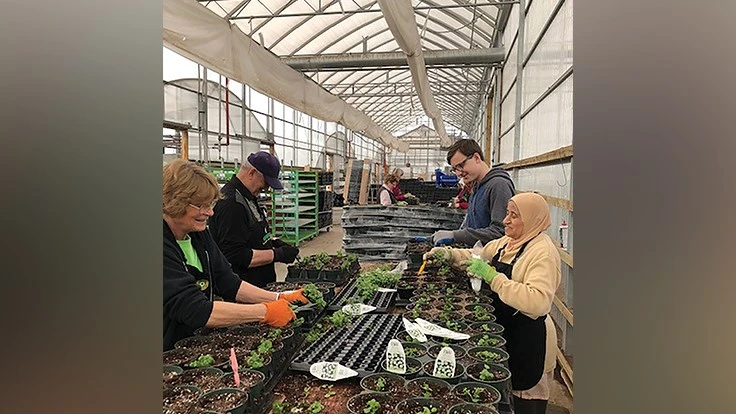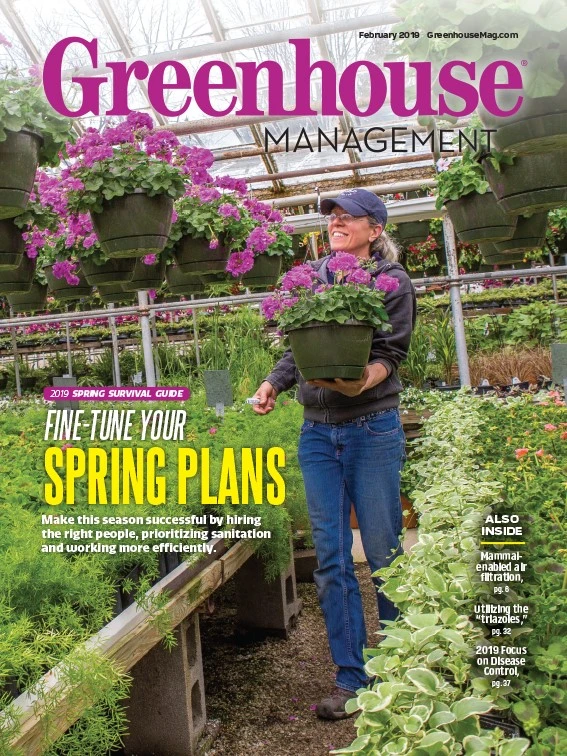
Photo courtesy of Kuhlmann’s Market Gardens and Greenhouses

On the cusp of another busy spring season, greenhouses are struggling to staff their expanding businesses. Due in part to a national unemployment rate hovering around 3.9 percent at press time (compared to 10 percent a decade ago), attracting and maintaining staff is a major pain point for growers.
See how three greenhouses are increasing the odds of filling seasonal positions.
N.G. Heimos Greenhouses and Millstadt Young Plants: Focusing on foreign labor
During the 2017 growing season, head grower Amy Morris struggled to fill 90 seasonal positions at N.G. Heimos Greenhouses and Millstadt Young Plants.
New hires, complaining about the heat and manual labor, often quit after a few weeks; some lasted just a single shift. The Millstadt, Illinois-based grower hired a total of 432 workers to tend to 100 acres of bedding plants over the course of the season.
“It was such a bad season with labor that our [permanent] staff were working 80 hours per week to cover the shortfall,” Morris recalls. “We knew we had to make a change.”
For the 2018 season, N.G. Heimos Greenhouses and Millstadt Young Plants hired workers through the H-2A visa program.

The greenhouse covered the cost of the visas, transportation from Mexico, housing and required extras such as transportation to local supermarkets for 60 temporary agricultural workers.
The impact was immediate: Order accuracy skyrocketed, no one complained about the heat or hard work and 100 percent of the temporary laborers completed the entire season, Morris says. She plans to continue hiring workers under the visa program and hopes to see many familiar faces when the crew arrives this spring.
“We’re hoping to rehire the same guys,” she says. “It’s 100 percent better to get the same group season after season.”
Morris still hires domestic workers, but she knows walk-in applicants will never fulfill her need for committed seasonal staff.
“Last season, we had 10 to 15 Americans come in looking for jobs; we hired eight. Only one lasted longer than a week,” she says. “With H-2A workers, we have confidence the work will get done.”
It takes an estimated 150-plus hours of paperwork to hire foreign workers on H-2A visas and requires a significant investment for growers, but Morris believes the effort is worthwhile, explaining, “The [return on investment] is huge.”

Kuhlmann’s Market Gardens and Greenhouses: Offering flexible roles
Anita McDonald knows few people want to do one repetitive task — i.e. transplant seedlings — for eight hours straight, so she offers seasonal staff the option to tackle different tasks within the greenhouse, from watering and cleaning to operating cash registers, assisting customers and, of course, transplanting.
The expansive job descriptions are just one of the ways Kuhlmann’s has tried to make seasonal positions more attractive to the 60 staff it hires each spring. The Edmonton, Alberta, greenhouse also offers flexible schedules — and only requires seasonal staff to commit to working one day on the weekend — and generous discounts.
“We want our workers to come back year after year so we do what we can to make seasonal employment work for them,” says McDonald, greenhouse manager at Kuhlmann's.
Although the greenhouse is known for its seedling annuals, including 25,000 geraniums and 5,000 hanging baskets, Kuhlmann’s has diversified its operations to include vegetable transplants, fresh vegetables and a Christmas shop. Extending the season means some seasonal staff can keep their jobs for longer.
“Being able to offer nine months of work when other greenhouses only offer four or five months of work makes this a more attractive place to work,” McDonald says.
In 2018, Alberta raised its minimum wage to $15 per hour, which McDonald believes has helped Kuhlmann’s attract seasonal staff.
“A higher minimum wage means more people are going to be out looking for work and that will increase our applicant pool,” McDonald explains. “But, at that rate, I’m looking for someone who is more knowledgeable and mature.”
In fact, some of her best hires have been retirees who are passionate about plants and interested in a short-term or seasonal role to supplement their income.
“Some of our most dedicated and loyal employees aren’t looking for careers,” McDonald says. “Our retirees are the ones that stay with us all season and come back year after year.”

Metrolina Greenhouses: Piling on the perks
Hiring 700-plus seasonal workers was difficult enough, but Metrolina Greenhouses faced an additional challenge: Its Huntersville, North Carolina, location had meager public transportation service.
“A lot of [potential hires] don’t have reliable transportation,” says human resources director Dave Dougherty. “Even if they wanted to work for us, they had no way to get here.”
In 2018, Metrolina Greenhouses, which has 168 acres under glass with an additional 38 acres of greenhouse space scheduled to come online in 2020, partnered with the Charlotte Area Transit System to operate an express bus from the light rail line to the greenhouse. This season, the grower is exploring options to subsidize transit passes to make public transportation an even more attractive option.
Transportation is just one of the perks Metrolina Greenhouses offers its workers. The greenhouse also hosts staff appreciation lunches and regular drawings for prizes such as tickets to concerts and sporting events. A starting wage of $11 per hour (the minimum wage in North Carolina is $7.25 per hour), with regular raises and opportunities to work overtime, also helps attract seasonal staff.
Metrolina Greenhouses also believes in “second-chance hiring” and works with community partners to provide opportunities to workers with criminal records. While the greenhouse still performs background checks and makes decisions on a case-by-case basis, human resources manager Phil Heilman calls the program a success, noting, “Our Employee of the Year was a second-chance hire.”
In 2018, Metrolina Greenhouses launched a “refer a friend” program that provides bonuses to seasonal and permanent staff when their referrals are hired. Metrolina Greenhouses offers $150 after a new employee works 30 days and an additional $150 when that employee hits the 60-day mark.
“We want to be able to fill a job once, not two-and-a-half times per season,” Dougherty says. “Enlisting all of our employees to be part of our hiring and retention process helps us with that.”

Explore the February 2019 Issue
Check out more from this issue and find your next story to read.
Latest from Greenhouse Management
- Anthura acquires Bromelia assets from Corn. Bak in Netherlands
- Top 10 stories for National Poinsettia Day
- Langendoen Mechanical hosts open house to showcase new greenhouse build
- Conor Foy joins EHR's national sales team
- Pantone announces its 2026 Color of the Year
- Syngenta granted federal registration for Trefinti nematicide/fungicide in ornamental market
- A legacy of influence
- HILA 2025 video highlights: John Gaydos of Proven Winners





